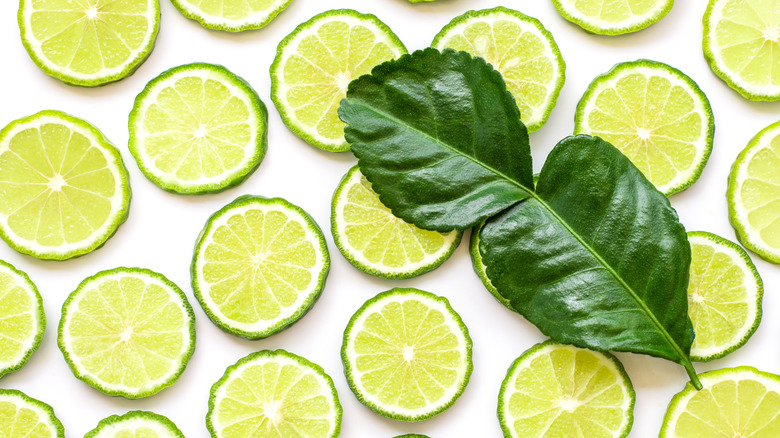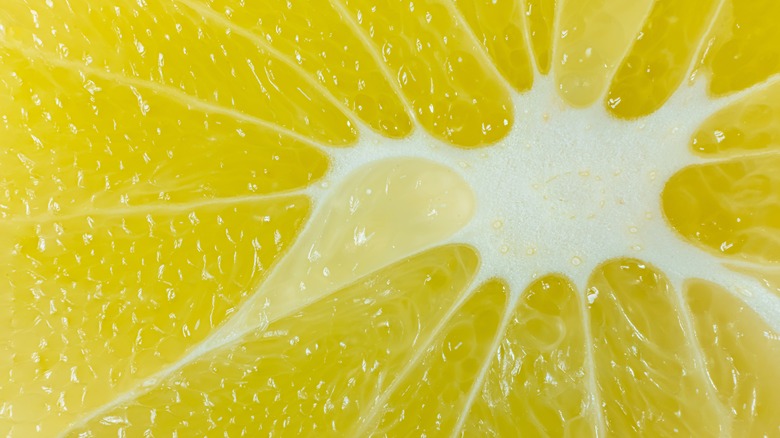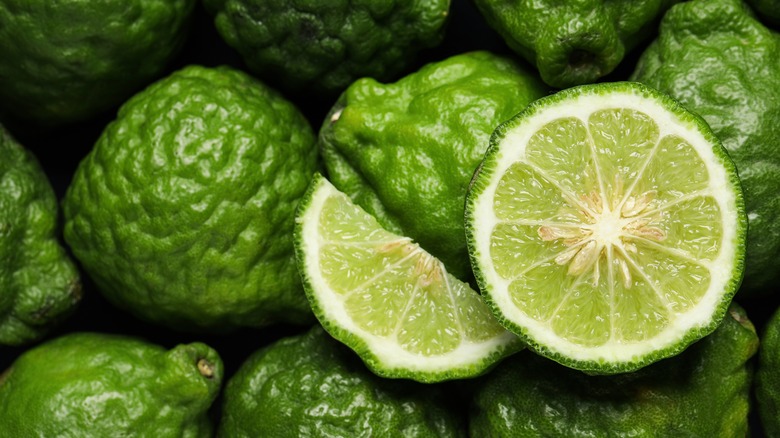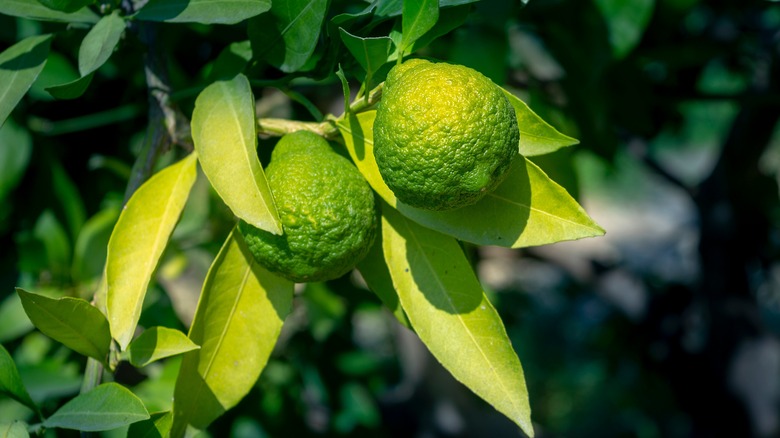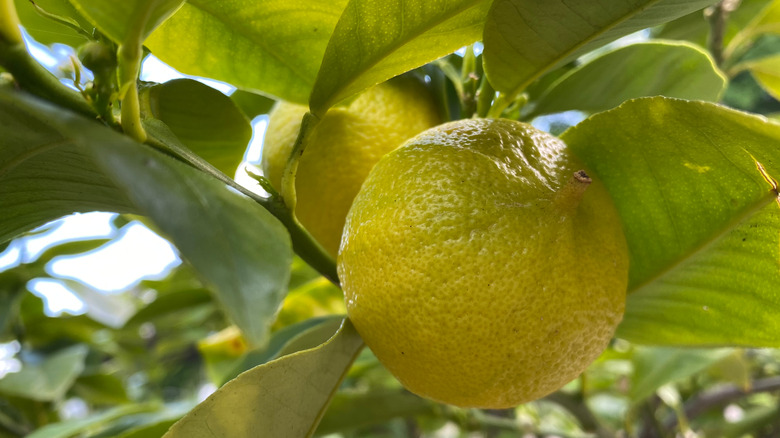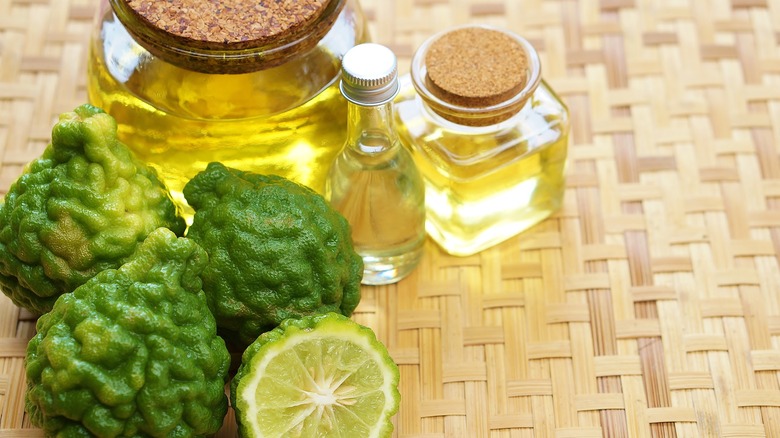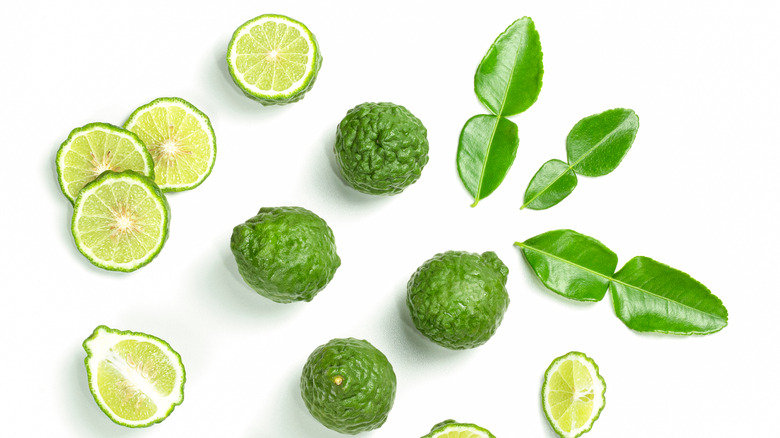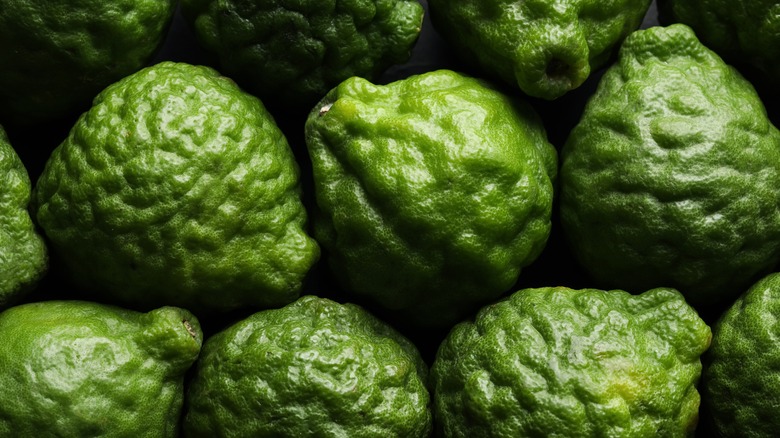Why The Bergamot Orange's Peel Is More Useful Than Its Fruit
If you've enjoyed a comforting mug of Earl Grey tea, you've tasted the essence of bergamot orange or Citrus bergamia. The fruit's pungent taste has made its way into a variety of recipes, from cocktails and pastries to marmalade and marinade. You may have even encountered bergamot in soap or essential oil used at the spa. For this reason, bergamot can be a bit of a confusing ingredient due to its range of uses — and the limitations of the fruit itself.
While the yellowish-green rind of this bitter orange is used more often than the fruit itself, bergamot oranges support health and add extra zest to recipes. Originally thought to be a hybrid of citron and Seville oranges, bergamot oranges have some mystery surrounding their precise geographical origins. The fruits have been grown in Italy since the middle of the 17th century and, to this day, are harvested along Italy's southwestern coast, but the fruit can also be found in South America and Africa.
Because the season for these oranges lasts only a few months each year, you'll want to grab them if you happen to find them in the market.
What is a bergamot orange?
Bergamot orange trees are evergreen, and tiny fragrant white flowers appear among the green leaves in the springtime. The round, dark green fruits ripen as colder winter months arrive, and the shiny, textured skin changes colors to bright lemony yellow.
Beneath the fruit's bumpy rind, a spongy white skin encircles a pale-yellow flesh that tastes extremely bitter. Yet what this fruit lacks in edibility, it more than makes up for with its aromatic fragrance. This essence is part of what gives Earl Grey its characteristic flavor.
While the bergamot fruit tree yields citrusy fruits, North America's bergamot herb is a kind of wildflower that offers plenty of pretty flowers but does not provide any fruit. Both the oranges and the herbs, however, have been used for medicinal purposes and incorporated into healing herbal teas. Just don't let the names fool you: these are two different plants.
Bergamot herb vs. bergamot oranges
The bergamot herb and the bergamot orange may share the same name, but these two ingredients are unique plants with different compositions. The bergamot herb is made up of thymol and citronellyl acetate, while the bergamot fruit carries neoeriocitrin, ponceritin, and mitrocin. The herb is found strictly in North America, but the oranges can be found in Italy, Morocco, Turkey, Argentina, and Brazil.
Though the herb and fruit are separate ingredients, both have been used for their antiseptic properties. Native American tribes used the bergamot herb to make teas and treat infections, even making mouthwash out of the herb. Citrus bergamot was and is also found in teas but has also made its way into sweets and been used as a spice in Turkish and Greek dishes for hundreds of years.
When using bergamot oranges in recipes, cooks need to know how to best maximize the taste and smell of this pungent fruit.
The unique smell of bergamot
Bergamot has a complex aroma, and it's a big part of why the fruit is harvested in the first place. While the more apparent smell of the citrus and the peel can be easier to note and describe, whiffs of coriander, pine, and rose can also be detected. Because the smell of the bergamot fruit offers a nuanced touch to recipes, bergamot fruit can complement other flavors and deepen the presence of fruits like tart yuzu and tangy kumquat. Bergamot oranges highlight and amplify the accompanying citrus profiles when mixed with lemons and other varieties of oranges.
The herbal, woody, and spicy elements of bergamot oranges pair well with herbs like fresh basil, rosemary, and sage. Because bergamot is so fragrant, it can hold its own when matched with other bold spices and flavors. Cinnamon, nutmeg, cumin, cardamom, and star anise can match bergamot's zing, while ginger and lemongrass also play well with the zesty smell of bergamot oranges. With their rich aroma, bergamot oranges can add satisfying depth to flavorful dishes.
What do bergamot oranges taste like?
To say that bergamot oranges are bitter is an understatement. When bergamot is used in recipes, it has to be incorporated thoughtfully. If you can imagine a mix of lemon and bitter orange, you can picture the acidic taste of this fruit.
A bergamot orange carries real zing. The sharp citrus taste can cause an unsuspecting eater's mouth to quickly and involuntarily pucker in protest. Because the fruit of the bergamot is deemed overpowering and bitter by most, oil taken from the fruit's rind is favored for culinary projects. Extracted from the bumpy skin, the oil combines floral and citrus notes that can stimulate the senses when incorporated into teas and baked goods. To make marmalade with bergamot, chefs generally compensate for the fruit's tartness with a generous amount of sugar. For those uncertain about the taste of the fruit, the oils from the rind can elevate recipes made at home.
How to use bergamot oranges
Despite it being a big part of how it gets used, bergamot isn't just for tea. Bergamot oranges aren't palatable eaten fresh, but they can be used flavor cookies and cocktails, even mayonnaise and pesto. Bergamot can lend a rich, unexpected flavor to proteins like fish and steak. You can even use the orange zest to spruce up custards, syrups, and baked treats that can benefit from an added layer of complexity. From chocolate truffles to ice cream, the rind of bergamot can quickly brighten recipes and complement other spices and flavors.
A little goes a long way when using bergamot. When mixing the ingredient into vinaigrette dressings or ricotta sides, add conservatively and taste as you go to ensure you're not putting yourself in the position of having to counteract the effect of too much bergamot added to your dish.
And if you bought a bag on a whim, try preserving the remaining fruit for longer use by making a syrup that can be easily splashed into recipes when needed.
Nutritional information about bergamot oranges
In addition to servings of potassium and calcium, bergamot oranges deliver ample doses of vitamins A, C, B1, and B2. Healthline says bergamot oil has been used to aid irritated digestive systems and relieve muscle pain. Further, the National Institute for Health (NIH) has published research that supports the notion that the oranges have anti-inflammatory and anti-oxidative properties. Bergamot has also been thought to reduce blood sugar levels, according to WebMD.
Whether consumed in tea or placed in an essential oil diffuser, the pleasant smell of bergamot oil can lift mood and calm stress, as seen in a report published by the NIH that came out of studies conducted at Kyoto's Prefectural University of Medicine. Traditional Ayurvedic medicine has known of these effects for some time, as bergamot has been used to treat symptoms of anxiety and depression.
If you can't find bergamot fruit in your local market, you can look for oils to bring the scent into your home. Just be sure to read product labels before attempting to incorporate store-bought oils into cooking recipes.
Where to buy bergamot oranges
Bergamot oranges can be a bit tricky to track down. Since the fruit is seasonal, these zesty oranges have a short window to end up in markets. Like other citrus fruits, bergamot oranges are in season from October to March. Similarly, your chances of finding bergamot oranges at your favorite grocers are higher during the cooler months, from November through late February. If you are able to buy the fruits themselves, make the most of every part! Use the rinds, zest, and fruit, and consider setting aside oil to use later on.
To buy bergamot oil, get your wallet ready. In order to make bergamot oil, around two hundred pounds of the fruit is needed to extract one pound of oil. If your local grocery doesn't carry the fruit or oil, check online, as several retailers will ship these products to locations across the U.S. and Europe.
